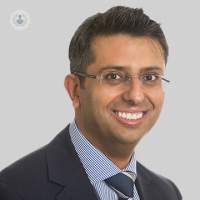Glue ear – the FAQs answered
Autore:Glue ear is a build-up of liquid in the middle ear. The middle ear is the part of the ear that lies behind the eardrum and is normally filled with air. Glue ear is so common that 8 out of 10 children will experience it and it usually affects children under the age of seven. It can be brought on by a cold and is more common in winter. In many children, it gets better without any treatment. Mr Sam Khemani, an experienced ENT surgeon, answers some FAQs on this common childhood health problem.

What are the signs of glue ear?
The main symptom of glue ear is hearing loss. Some children with glue ear will talk louder or increase the volume when watching TV or playing with devices. Sometimes, parents or teachers may notice problems with a child’s speech or pronunciation. The level of hearing loss is quite similar to a person with their fingers in their ears.
Is glue ear permanent?
No - in many children it will resolve without treatment. It is fairly common to see in children after a cold or other viral-type infections. Treatment is offered if it persists for longer than three months.
Can adults get glue ear?
Yes - but it is much less common compared with children. Most adults who develop glue ear find that it has been brought on by a bad viral infection or after airline descent when travelling. Adults who develop glue ear on one side need to be assessed urgently to exclude the rare possibility of cancer of the nasopharyngeal (back of the nose).
How is glue ear treated?
If a child is found to have glue ear, they will have a hearing test to establish the level of hearing problems. If glue ear with hearing loss is confirmed then it is a good idea to try the Otovent balloon®. This simple device can be bought online and uses a balloon that the child blows up with their nose. Doing this regularly has been shown to help some children with glue ear get better.
If the glue ear does not get better after three months and another hearing test continues to show hearing loss, then the child will usually be offeredgrommet surgery or, in some cases, a hearing aid.
What are grommets?
Grommets are small plastic tubes inserted into the eardrum, which allow air to enter the middle ear to replace the fluid. This type of surgery is one of the most common types of surgery performed in children and is performed as a day-case procedure. Sometimes it is performed at the same time as removing the adenoids as this has been shown to be more effective when treating persistent glue ear.
Grommets normally last 6 to 12 months and fall out on their own without the need to remove them. Once the grommets have fallen out, the majority of children will have normal hearing, but the procedure can be repeated if children have on-going problems.
The outlook for children with glue ear is very good and most children have excellent results from treatment.


